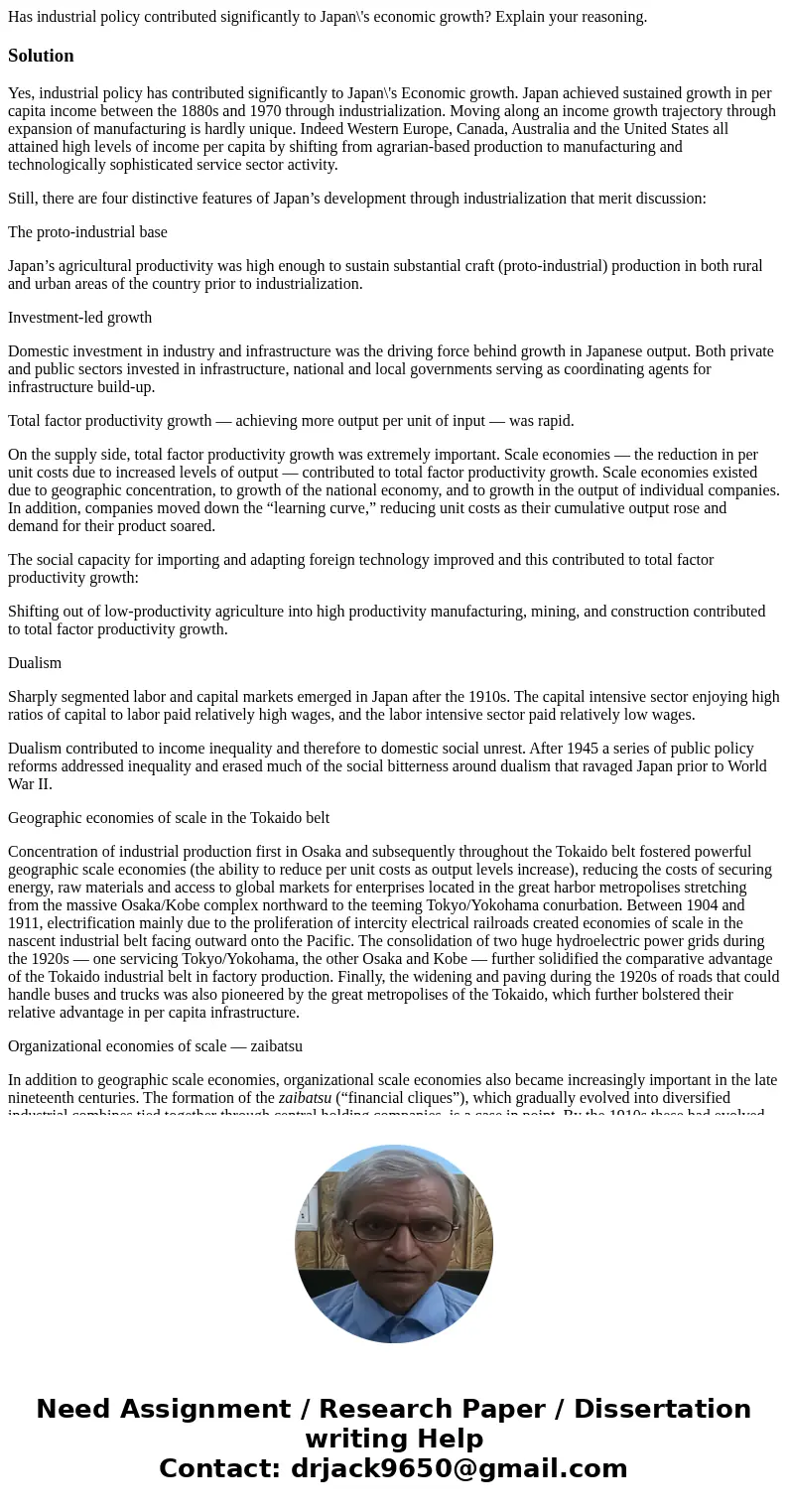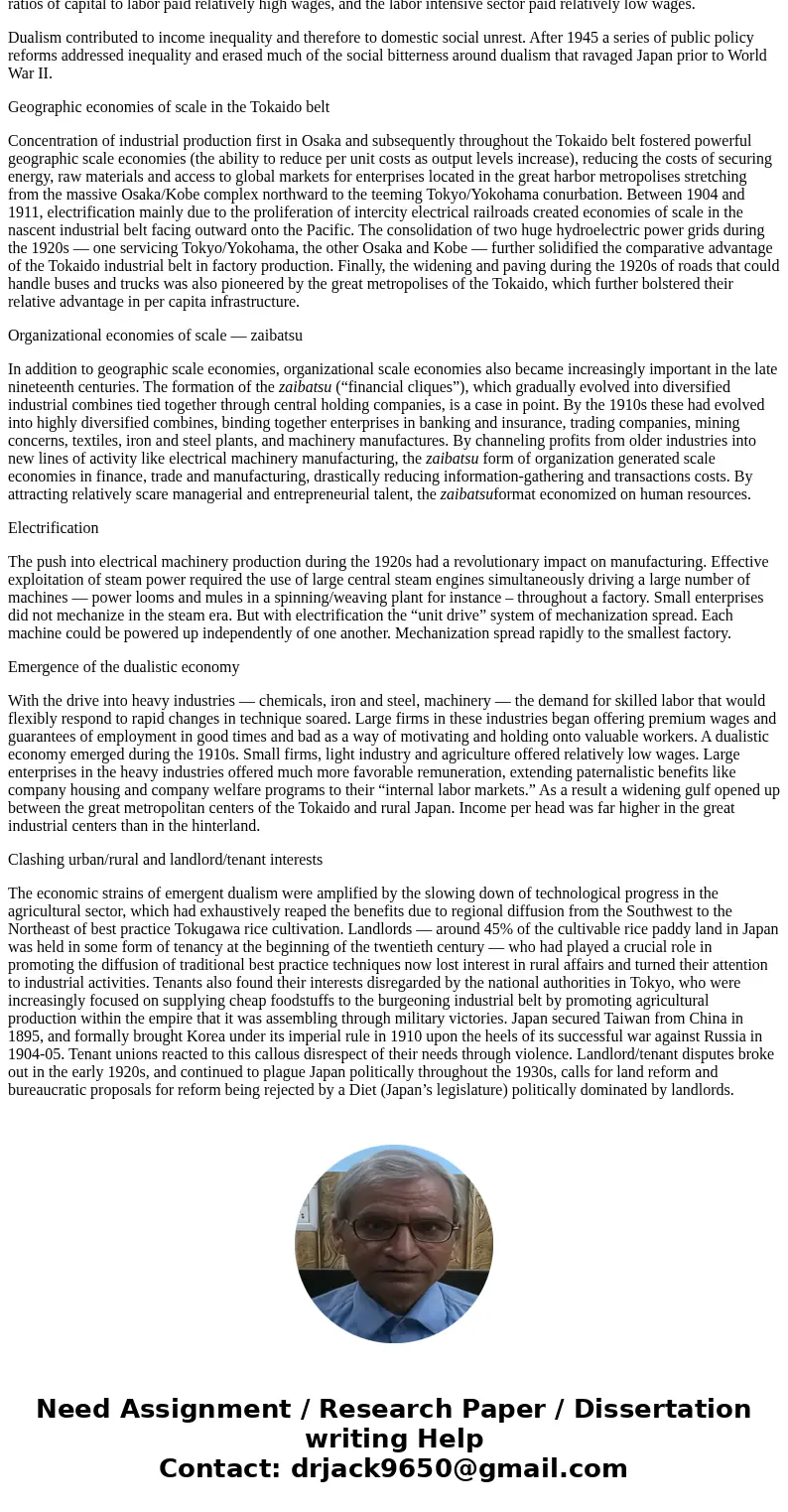Has industrial policy contributed significantly to Japans ec
Has industrial policy contributed significantly to Japan\'s economic growth? Explain your reasoning.
Solution
Yes, industrial policy has contributed significantly to Japan\'s Economic growth. Japan achieved sustained growth in per capita income between the 1880s and 1970 through industrialization. Moving along an income growth trajectory through expansion of manufacturing is hardly unique. Indeed Western Europe, Canada, Australia and the United States all attained high levels of income per capita by shifting from agrarian-based production to manufacturing and technologically sophisticated service sector activity.
Still, there are four distinctive features of Japan’s development through industrialization that merit discussion:
The proto-industrial base
Japan’s agricultural productivity was high enough to sustain substantial craft (proto-industrial) production in both rural and urban areas of the country prior to industrialization.
Investment-led growth
Domestic investment in industry and infrastructure was the driving force behind growth in Japanese output. Both private and public sectors invested in infrastructure, national and local governments serving as coordinating agents for infrastructure build-up.
Total factor productivity growth — achieving more output per unit of input — was rapid.
On the supply side, total factor productivity growth was extremely important. Scale economies — the reduction in per unit costs due to increased levels of output — contributed to total factor productivity growth. Scale economies existed due to geographic concentration, to growth of the national economy, and to growth in the output of individual companies. In addition, companies moved down the “learning curve,” reducing unit costs as their cumulative output rose and demand for their product soared.
The social capacity for importing and adapting foreign technology improved and this contributed to total factor productivity growth:
Shifting out of low-productivity agriculture into high productivity manufacturing, mining, and construction contributed to total factor productivity growth.
Dualism
Sharply segmented labor and capital markets emerged in Japan after the 1910s. The capital intensive sector enjoying high ratios of capital to labor paid relatively high wages, and the labor intensive sector paid relatively low wages.
Dualism contributed to income inequality and therefore to domestic social unrest. After 1945 a series of public policy reforms addressed inequality and erased much of the social bitterness around dualism that ravaged Japan prior to World War II.
Geographic economies of scale in the Tokaido belt
Concentration of industrial production first in Osaka and subsequently throughout the Tokaido belt fostered powerful geographic scale economies (the ability to reduce per unit costs as output levels increase), reducing the costs of securing energy, raw materials and access to global markets for enterprises located in the great harbor metropolises stretching from the massive Osaka/Kobe complex northward to the teeming Tokyo/Yokohama conurbation. Between 1904 and 1911, electrification mainly due to the proliferation of intercity electrical railroads created economies of scale in the nascent industrial belt facing outward onto the Pacific. The consolidation of two huge hydroelectric power grids during the 1920s — one servicing Tokyo/Yokohama, the other Osaka and Kobe — further solidified the comparative advantage of the Tokaido industrial belt in factory production. Finally, the widening and paving during the 1920s of roads that could handle buses and trucks was also pioneered by the great metropolises of the Tokaido, which further bolstered their relative advantage in per capita infrastructure.
Organizational economies of scale — zaibatsu
In addition to geographic scale economies, organizational scale economies also became increasingly important in the late nineteenth centuries. The formation of the zaibatsu (“financial cliques”), which gradually evolved into diversified industrial combines tied together through central holding companies, is a case in point. By the 1910s these had evolved into highly diversified combines, binding together enterprises in banking and insurance, trading companies, mining concerns, textiles, iron and steel plants, and machinery manufactures. By channeling profits from older industries into new lines of activity like electrical machinery manufacturing, the zaibatsu form of organization generated scale economies in finance, trade and manufacturing, drastically reducing information-gathering and transactions costs. By attracting relatively scare managerial and entrepreneurial talent, the zaibatsuformat economized on human resources.
Electrification
The push into electrical machinery production during the 1920s had a revolutionary impact on manufacturing. Effective exploitation of steam power required the use of large central steam engines simultaneously driving a large number of machines — power looms and mules in a spinning/weaving plant for instance – throughout a factory. Small enterprises did not mechanize in the steam era. But with electrification the “unit drive” system of mechanization spread. Each machine could be powered up independently of one another. Mechanization spread rapidly to the smallest factory.
Emergence of the dualistic economy
With the drive into heavy industries — chemicals, iron and steel, machinery — the demand for skilled labor that would flexibly respond to rapid changes in technique soared. Large firms in these industries began offering premium wages and guarantees of employment in good times and bad as a way of motivating and holding onto valuable workers. A dualistic economy emerged during the 1910s. Small firms, light industry and agriculture offered relatively low wages. Large enterprises in the heavy industries offered much more favorable remuneration, extending paternalistic benefits like company housing and company welfare programs to their “internal labor markets.” As a result a widening gulf opened up between the great metropolitan centers of the Tokaido and rural Japan. Income per head was far higher in the great industrial centers than in the hinterland.
Clashing urban/rural and landlord/tenant interests
The economic strains of emergent dualism were amplified by the slowing down of technological progress in the agricultural sector, which had exhaustively reaped the benefits due to regional diffusion from the Southwest to the Northeast of best practice Tokugawa rice cultivation. Landlords — around 45% of the cultivable rice paddy land in Japan was held in some form of tenancy at the beginning of the twentieth century — who had played a crucial role in promoting the diffusion of traditional best practice techniques now lost interest in rural affairs and turned their attention to industrial activities. Tenants also found their interests disregarded by the national authorities in Tokyo, who were increasingly focused on supplying cheap foodstuffs to the burgeoning industrial belt by promoting agricultural production within the empire that it was assembling through military victories. Japan secured Taiwan from China in 1895, and formally brought Korea under its imperial rule in 1910 upon the heels of its successful war against Russia in 1904-05. Tenant unions reacted to this callous disrespect of their needs through violence. Landlord/tenant disputes broke out in the early 1920s, and continued to plague Japan politically throughout the 1930s, calls for land reform and bureaucratic proposals for reform being rejected by a Diet (Japan’s legislature) politically dominated by landlords.


 Homework Sourse
Homework Sourse